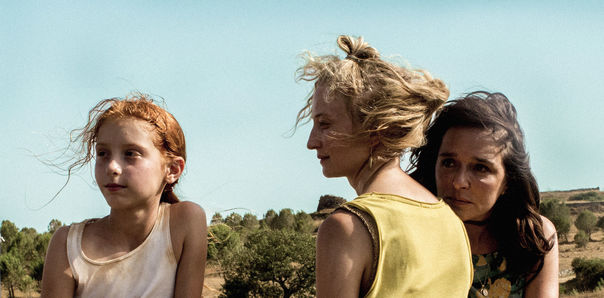THE POWER OF INVISIBLE TIES
By Domoina Ratsara

© Vivo film / Colorado Film / Match Factory Productions / Bord Cadre Films / Valerio Bispuri
“Secrets”, this year’s theme for Berlinale Talents, is a perfect fit for film narrative. The act of keeping and revealing secrets from the spectator, or even between characters, is at the heart of the cinematic technique to create a complex dynamic in storytelling. Also, one could wonder how moving images bear hidden messages about us and our society, and our relationship with others.
These questions emerge in a couple of films shown at the 68th Berlinale, which deal with mother-daughter relationships. Laura Bispuri’s Figlia Mia (Daughter of Mine, Italy), premiered in Competition, and Ramon Salazar’s La Enfermedad del Domingo (Sunday's Illness, Spain), in the Panorama programme, bear this idea in common. Both also explore the theme of abandonment and forgiveness.
In Figlia Mia, Tina and Angelica are two women connected by a secret who battle for the affection of 10-year-old Vittoria. The film follows the turbulent journey of the child’s instinctive sense that she wasn’t raised by her birth mother, at the same time as it portrays Angelica’s discovery of motherhood and Tina’s desperate search for meaning in her life.
La Enfermedad del Domingo, in turn, sets Chiara and her mother Anabel in a reciprocal quest for trust and love. Anabel left Chiara when she was only eight years old and has never seen her since. While Anabel is afraid of her daughter’s attitude after tracking her down, Chiara fears rejection. From the beginning, we know this is not a simple reunion.
Revealing secrets
In both films, the two daughters are guided by pure instinct. Figlia Mia opens with a handheld camera following Vittoria as she accidentally surprises Angelica having sex with a man in broad daylight. Bispuri clearly wants to get the viewers involved in this discovery of the woman for which Vittoria will later have a great fascination – even though the way she portrays the situation already paves the way to a moral judgement of Angelica.

On the verge of being evicted and leaving town, Angelica asks Tina to see the child, breaking an old agreement. After that, Vittoria keeps returning to her, without telling Tina – which adds another secret layer to the situation. When one of Tina’s co-workers warns her that she saw Vittoria coming back from the mountain, Tina refuses to believe her. “She’s the only one who has this red hair,” she hears, the one confirmation she wasn’t expecting to hear – and a hint that everybody in town knows about Tina’s secret, since Angelica and Vittoria bear an obvious physical resemblance.
In La Enfermedad del Domingo, Chiara first sees her mother by infiltrating one of her fancy parties as a waitress. While Chiara pours red wine for Anabel, who clearly asked for white wine, she draws her mother’s attention – and we see, by Anabel’s unease with the situation, that another secret is about to be revealed. “She feels the smell of her daughter. There is something… animal. They acted with pure instinct. They don’t know each other but they recognise each other, they understand each other,” said the director at the Berlinale press conference.
Salazar keeps his camera close to his subjects as Chiara invites Anabel to spend ten days at her house in the mountains. Without knowing Chiara’s exact intentions, Anabel accepts to follow her. There appears to be little genuine rapport between them, but with subtlety and sympathy, the director invites the viewers to share Chiara’s sense of forgiveness. La Enfermedad del Domingo is about this trust-building process between the two characters.
Something wrong about happiness
Prior to this moment, Salazar gives us explicit visual hints of imperfection hidden in an apparently perfect lifestyle. When we first meet Anabel, who has impeccable looks and a beautiful gown, she seems to lead a life of considerable luxury. The film opens with a wide shot of her mansion hall, which Anabel crosses elegantly before suddenly stumbling. “There is a gap in this perfection. There is something wrong,” explains Salazar. Anabel is shot from the front, in the dark, so that we can’t really see her face distinctively. With a sober aesthetic, the director brilliantly portrays this woman with no facial expression, haunted by her past.
In Figlia Mia , Bispuri portrays Tina as a caring and loving mom. She seems to be very happy having Vittoria with her and at gaining her affection and trust. She thinks she’s safe, as long as Vittoria doesn’t know the truth about Angelica. But there is fear in her eyes, emphasised by close-ups on her worried face, though the film evolves in a warm and colourful atmosphere. Yet the handheld and mobile camera reveals turbulent feelings as it follows Tina on her mission to bring provisions to Angelica.
Rhetoric of bareness everywhere
A rhetoric of bareness is also present in the two films. Angelica is living in very poor conditions. She has old horses, a few animals and a house from which she will be thrown out. This barrenness, this lack of ornamentation, and the nakedness of the landscape shown through a long shot from the top of the mountain reflect an idea of infertility. La Enfermedad del Domingo explores this same rhetoric in a different way, through the huge gap separating daughter and mother. While Anabel lives in a palace, Chiara inhabits an old countryside house in which everything is aged and ordinary. Salazar goes through this idea of bareness and nakedness in a scene he calls a “closing circle”, during which Anabel and Chiara take off their clothes before going into a lake.
Desire and the need for intimacy are at the heart of this classic plot. Salazar designs his film as a “small scale movie”, very private, taking place in this house in a remote location, where characters are trapped by long, lingering close-ups on individual faces. With a hypnotic atmosphere, revealing the invisible tension between the mother and the daughter, Salazar’s film stands out with its forceful visual impact.
In Figlia Mia , Bispuri plays with light effects to build the warm and sunny atmosphere that frames Vittoria’s discovery, intensifying her fascination and semi-unavowed happiness at finding her birth mother. When it comes time for Tina and Angelica to talk seriously about the “issue”, the aesthetics of the film shift considerably, as the director uses more shadows and dialogue than before.
Both films have particular ways of revealing secrets to the audience and to each character. “Why am I here?” Anabel often asks without really receiving a clear response from Chiara. In the first moment that a secret is revealed in the film, it is shared by the two protagonists, as Chiara pours the wrong wine in Anabel’s cup. A little while later, however, he gives the audience a better hint of the secret, as he shows a close-up of the paper where Chiara left a note– setting a rendezvous. Following that, Anabel’s husband and daughter will be informed of Chiara’s existence. In Figlia Mia , on the other hand, secrecy revelation is more about trusting to dialogue. Bispuri avoids making a mystery of the screenplay. It is set from the beginning that Angelica is the birth mother. Both films try to show the complexity of mother-daughter relationships, and the power of the invisible ties that can lead to forgiveness and acceptance.

